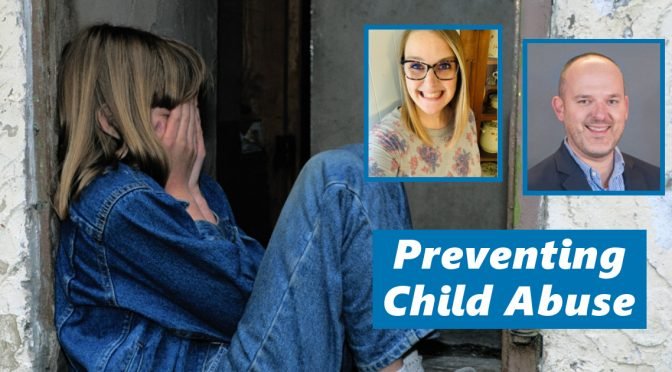National Child Abuse Prevention Month 2020: Keeping Children Safe in the Age of “Social Distancing”

“The true character of a society is revealed in how it treats its children.” — Nelson Mandela
We have long known the harmful effects that childhood abuse or neglect (also known as “child maltreatment”) can have on a person’s life. Child maltreatment can lead to long-lasting negative consequences for an individual’s physical and psychological health and create behavioral issues that persist into adulthood. However, it is still shockingly common. In 2018 alone, an average of 9.2 out of every 1,000 children—a total of 678,000 children—were the victims of child maltreatment in the U.S., according to the 2018 Child Maltreatment Report from the Children’s Bureau of the U.S. Department of Health & Human Services. In Indiana, the rate was 16.4 out of every 1,000 children, making our state the 9th highest in the country for reported instances of child abuse.
The Federal Child Abuse Prevention and Treatment Act, passed in 1988, defines child abuse and neglect as “any recent act or failure to act on the part of a parent or caretaker, which results in death, serious physical or emotional harm, sexual abuse or exploitation, or an act or failure to act which presents an imminent risk of serious harm.” Since abuse is often perpetrated by a member of the immediate family, the burden of detecting and reporting abuse typically falls on the shoulders of adults outside the family, such as teachers, counselors, relatives, neighbors, medical professionals, religious leaders and members of law enforcement.
However, the ongoing COVID-19 crisis has made it much more difficult for victims of child abuse to receive help. School closures and social distancing guidelines have given children fewer opportunities to interact with individuals who could provide assistance, which means that we must all be more vigilant about detecting abuse. This sentiment is shared by Kevin Carr of Sheltering Wings, a domestic violence shelter based in Danville, IN:

“When families are isolated, the reporting structures for abuse are interrupted. Victims are in closer proximity to their abusers and at the same time are isolated from anyone who could offer help. The primary message we’re trying to convey right now is that neighbors, ministers, therapists—anybody who has the chance of interacting with the family—need to be watching and observing when possible. That takes some skills that we’re not all used to using, or maybe we haven’t developed, but we have to become better at watching and listening closely and being able to interject in ways that are not only helpful, but safe. We’re responsible for each other, and everyone has a part to play.” - Kevin Carr, Development and Communications Officer at Sheltering Wings
In light of the heightened risk of abuse that children are currently facing, and in honor of National Child Abuse Prevention Month, we spoke with Raychel Hamby, one of our care providers who works in coordination with the Indiana Department of Child Services (or DCS). In this post, Raychel explains how we can all spot warning signs of abuse in the children we interact with, including the proper way to respond when abuse is suspected.
Raychel Hamby on the Warning Signs of Child Abuse

“I’m the point-person and liaison in our county for all of our services that we provide to those in DCS,” says Raychel Hamby, LMHC, Montgomery County DCS and Outpatient Team Lead at Cummins Behavioral Health.
For many of us, the best thing we can do to help prevent child abuse is know how to detect it. Although some children will speak up about abuse before it becomes severe, many others unfortunately will not. “Through my experience working with DCS for so many years, it really depends on the child’s personality and the family values,” Raychel explains. “In families that teach ‘what happens here stays here,’ those children typically won’t explicitly tell you what’s going on unless it becomes so severe that they finally say something.”
However, there are many telltale signs that professionals who work with children use to spot potential abuse. While these signs do not guarantee that abuse is occurring in the home, they do warrant additional scrutiny and investigation. The presence of multiple signs typically indicates a greater likelihood of abuse.
According to Raychel, here are some of the most common signs of abuse that behavioral health professionals look for when working with children:
- Suspicious bruises: Bruises that seem unlikely to have resulted from regular play, such as bruises on the face or bruises in the shape of handprints, are some of the most common signs of physical abuse. “The child may say, ‘I fell down the stairs,’ but if you know there are no stairs in the house, then you know that story is not true. And if it’s the middle of summer and the child’s wearing long-sleeve clothes, then the parents may be trying to cover up the bruising,” Raychel adds.
- Cowering behavior: Physical abuse can also cause a child to develop an instinctive fear response to adults. “When you approach them, they become scared and cower,” Raychel explains. “They’re so traumatized that they feel threatened and respond fearfully to any type of authority figure.”
- Violent behavior or excessive anger: Alternatively, a child may internalize the violence of physical abuse or perpetuate it as a way of coping. “They could be acting out and hitting other kids, or they could become angry in situations where that level of anger is not appropriate,” Raychel says.
- Isolating behavior: A child who is being emotionally abused may exhibit signs of developmental regression, which frequently manifests as isolating behavior. “If you know the child is typically outgoing, and all of a sudden they’re isolating and don’t seem like their normal selves, that could be a sign of emotional abuse,” Raychel says.
- Low weight or frequent requests for food: If a child is underweight or emaciated in appearance, then they might not be receiving enough food at home, which could be a sign of neglect. The likelihood of neglect is even higher if the child frequently comments that they are hungry or asks others for food.
- Lack of parental supervision: Children who spend a lot of time outside the home without supervision might also be suffering from neglect. This particular sign often indicates that the parents may be using substances. “A major concern for DCS right now is families that are using substances,” Raychel explains. “The children run the street and usually get in delinquent behavior, or they may be using substances themselves.”
- Many people going in and out of the home: High volumes of traffic in and out of the child’s home can also indicate that their parents are using substances, especially if you don’t recognize the individuals as family members or friends of the family. If the child also exhibits behavioral issues, then neglect as a result of substance use is likely.
- Rarely spending time outside the home: If a child is rarely seen outside the home, there’s a chance that they are suffering abuse and their parents are attempting to isolate them from others who could help. “Does the child not get to go outside, or if they do, do they have to come back in after a few seconds? Sometimes these are signs of abuse because the parents don’t want others to see the child,” Raychel explains.
- Cries for help on social media: Finally, children who are suffering from abuse may use social media to alert others to their situation. However, they will typically only hint at their emotional distress rather than disclosing the full nature of the abuse that’s occurring. “In one case I’m working on, the daughter was posting on social media about suicide,” Raychel says. “Her parent’s mental health had gotten so bad that she just wanted out of the situation, and that was a sign of neglect that got DCS involved.”
What to Do If You Suspect Child Abuse

The second component of effective child abuse prevention is knowing how to respond when abuse is suspected. If you believe that a child is suffering from abuse, it is highly inadvisable to confront the suspected abuser directly. While you may feel that it’s your duty to personally put a stop to the situation, it is often wiser to bring in child welfare professionals.
“If your gut is telling you that something is going on in a home—abuse, neglect, substance use, anything of that nature—it’s best to make a DCS Hotline report,” Raychel says. The Indiana Child Abuse and Neglect Hotline is answered 24 hours a day, seven days a week (including all holidays), and the identity of callers is never disclosed outside the agency. Once a report is made, DCS will determine the likelihood that abuse is occurring, send out an assessor if appropriate, and begin the necessary procedures to address the situation.
In addition to securing a safe living environment for the child, DCS may refer them or their parents for services with a behavioral health provider like Cummins BHS. As Raychel explains, the type of support provided can vary widely based on the circumstances:
“We do an intake assessment, make the appropriate recommendations, and then follow up with the family. In general, our heaviest involvement is due to substance use. In extreme cases, the child may be removed from their parents, and the parents would complete substance use treatment. We also have cases where a child isn’t attending school due to their parents’ substance use, so we would help the parents develop structure and address whatever is keeping the child from getting to school. We also work with kids who’ve been through trauma—sexual abuse, emotional abuse and physical abuse—that are in foster care. DCS will usually get us involved to help the foster placement provide support and nurturing to the child they have in their home, because the child will probably have behavioral issues from the trauma.”
The safety and well-being of children is always the top priority when abuse has occurred, but it should be noted that protective services never wish to break up families. Whenever possible, the intention is to rehabilitate abusers and mend fractures in family harmony. As Raychel Hamby says, “Our goal when we get involved is always to assist the family in reunifying. Our goal is never to keep the children away from their family, but to help the family establish healthy boundaries, structures and routines.”
During these challenging times, we are all responsible for the well-being of our most vulnerable community members. If you suspect that a child you know is suffering from abuse, please call the Indiana Child Abuse and Neglect Hotline at 1-800-800-5556 to make a report. Your call may be the critical first step in protecting a child!

Looking for more information about domestic violence and children’s behavioral health? Here are a few more articles we recommend!
